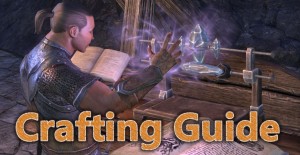 Elder Scrolls Online has, according to numerous players and critics, one of the best if not the best crafting systems in any MMORPG. The developers certainly made sure to make crafting meaningful, useful and even fun. With a vast amount of recipes and features like crafting styles there’s always going to be a market for your wares. This is further evident considering the best equipment in game can not only be obtained from dungeons or Cyrodiil, but also crafted by players who dedicate enough time to crafting.
Elder Scrolls Online has, according to numerous players and critics, one of the best if not the best crafting systems in any MMORPG. The developers certainly made sure to make crafting meaningful, useful and even fun. With a vast amount of recipes and features like crafting styles there’s always going to be a market for your wares. This is further evident considering the best equipment in game can not only be obtained from dungeons or Cyrodiil, but also crafted by players who dedicate enough time to crafting.
Contents:
- Basics
- Gathering Materials
- Crafting Stations
- Crafting Process
- Extraction
- Research and Traits
- Crafting Styles
- Improvement
- Leveling
Basics
There are six professions available:
- Alchemy – used to create various potions with short-term effects
- Blacksmithing – creates metal weapons and Heavy armor
- Clothing – used to craft Light and Medium armors
- Enchanting – adds various stats and attributes to your weapons, armor or jewelry
- Provisioning – creates various consumable drinks and food which provide your character buffs (unlike potions, food effects usually last half an hour)
- Woodworking – uses wood materials to create Bows, Staves and Shields
- Jewelry Crafting – creates Rings and Necklaces
You can start gathering materials and crafting basic items in any of these professions at the start of the game. Crafting more powerful items and more potent consumables must be unlocked by putting skill points in crafting skill trees. To be able to craft higher level items, Alchemy and Woodworking both require 6 skill points each, while other 4 tradeskills require 9 points. You can spend way more skill points into each crafting skill line, but they will only decrease your research time, improve the chance to extract materials, or increase your chances to improve items.
In Alchemy skill tree you can spend a total of 19 SP, and 22 in Enchanting. Other professions take 24 skill points each to fully maximize their benefits. That means you will need 137 skill points to fully maximize every passive in each of these six tradeskills, so considering your character can obtain close to 300 skill points it’s even possible to be fully proficient in every crafting skill. Say goodbye to crafting alts!
Gathering Materials
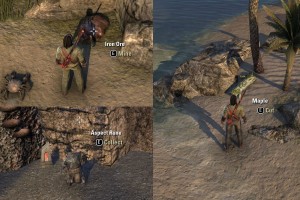 Crafting materials can be obtained by looting monsters, crates, chests, urns, cabinets and other similar objects. There are also crafting nodes with “organic” materials that spawn throughout Tamriel, such as Iron Ore (blacksmithing), Jute (clothing), or Runes (enchanting). Various herbs are also common, as is wood.
Crafting materials can be obtained by looting monsters, crates, chests, urns, cabinets and other similar objects. There are also crafting nodes with “organic” materials that spawn throughout Tamriel, such as Iron Ore (blacksmithing), Jute (clothing), or Runes (enchanting). Various herbs are also common, as is wood.
Any character can interact with resource nodes and pick up crafting materials regardless of their proficiency in any of the tradeskills! Unlike in Skyrim you also don’t need to carry around any Pickaxes or similar items to gather ore. All professions with gathering nodes also have “Keen Eye” passives which basically make respective nodes glow once you’re near them, making them extremely easy to spot. If convenient be sure to always pick up all crafting materials and gather any nodes you come across — even if you don’t intend to use the materials yourself sometimes you can get rare and valuable ones which you can resell for gold to other players.
Crafting Stations
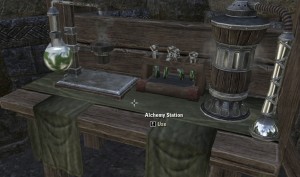 Crafting stations are used to actually craft items, and can be found in many locations in Tamriel. All towns and cities have crafting stations for all six professions, and you can even find some while adventuring in the open. You can’t craft items unless you interact with the appropriate crafting station!
Crafting stations are used to actually craft items, and can be found in many locations in Tamriel. All towns and cities have crafting stations for all six professions, and you can even find some while adventuring in the open. You can’t craft items unless you interact with the appropriate crafting station!
Crafting stations include the anvil or cooking fire or similar — objects you need to interact with to craft items in appropriate professions. Worth noting is that you don’t need to carry crafting materials in your inventory — the materials you have stored in your bank will also be available for use!
World Crafting Stations
There are also World Crafting Stations — special locations in Tamriel where you can craft specific items. The attached image shows one of the crafting stations where you can create Death’s Wind item set. This set bonus will cast an AoE knockback once every three minutes once you drop below 35% of your health, and this bonus can only be gained by crafting items at this specific locale.
In level 5-15 (Stonefalls, Auridon, Glenumbra) zones you can find three different world crafting stations each with its own set bonus:
- Death’s Wind: when struck by a melee attack this bonus triggers an AoE knockback, once every three minutes.
- Night’s Silence: your health regeneration is increased by 40% when hidden.
- Ashen Grip: small chance to breathe extra fire damage on every melee hit.
There are many more item sets and crafting locales, these are just the first ones you come across. To craft a set item you will first need to research at least 2 traits on that specific item slot.
Crafting Process
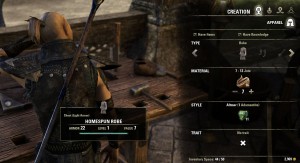 To craft items you need to find an appropriate crafting station somewhere in the world as explained above. Some crafts will require you to refine materials first, so for example you’ll need to refine your Iron Ore into Iron Ingots first. The exact crafting process is only slightly different for every profession, but these are all explained step by step in profession-specific guides.
To craft items you need to find an appropriate crafting station somewhere in the world as explained above. Some crafts will require you to refine materials first, so for example you’ll need to refine your Iron Ore into Iron Ingots first. The exact crafting process is only slightly different for every profession, but these are all explained step by step in profession-specific guides.
Essentially, it goes like this: you find a crafting station, select an item type you want to craft, traits, crafting materials, styles and you’re pretty much done. While there are some more complex things revolving around crafting, the actual creation process is fairly straightforward.
Extraction
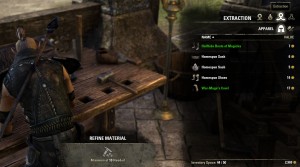 Extraction (also known as deconstruction) is used to gain materials from existing items, and can be used for Blacksmithing, Clothing, Woodworking, Enchanting and Jewelcrafting. The process is very simple: visit a crafting station, click on the extraction tab and select an item you want to deconstruct. Extraction will allow you to get materials, traits, inspiration, resins, or tempers from existing items, but will destroy the original items in the process.
Extraction (also known as deconstruction) is used to gain materials from existing items, and can be used for Blacksmithing, Clothing, Woodworking, Enchanting and Jewelcrafting. The process is very simple: visit a crafting station, click on the extraction tab and select an item you want to deconstruct. Extraction will allow you to get materials, traits, inspiration, resins, or tempers from existing items, but will destroy the original items in the process.
Extraction is also actually used to refine your raw materials into craftable ones. As such you’d need to gather raw wood in the world, then refine it in the extraction tab while on a woodworking station to get sanded wood you can use to craft items. By extracting items you can only get the materials required to construct it, so for example you can’t get higher level Ebony Ore from some low-level iron armour. Extracting from higher quality items also yields more materials (for quality look below under Improvement) and more Inspiration Points (IP).
Research and Traits
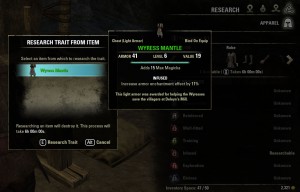 Research allows you to destroy existing items to learn their “traits”: various bonuses your character gains by equipping those items. The bonuses can be something like resistance to critical hits, improved spell resistance or reduced magicka cost of spells. To research these traits you’ll need to have an item with the exact trait in your inventory — once you start the research process the item will be destroyed, so be careful not to deconstruct anything you’re using!
Research allows you to destroy existing items to learn their “traits”: various bonuses your character gains by equipping those items. The bonuses can be something like resistance to critical hits, improved spell resistance or reduced magicka cost of spells. To research these traits you’ll need to have an item with the exact trait in your inventory — once you start the research process the item will be destroyed, so be careful not to deconstruct anything you’re using!
Researching takes time — real time. Some of the basic trait researches will take 6 hours, and later on they can even take several days to complete. Again, I’m talking about actual real world time, however you don’t have to be logged into the game during the research process. You can only research one trait at any given time, but you can spend skill points in respective crafting skill trees to reduce the research time by up to 25% and be able to research up to 3 traits in the same time.
You can research traits in multiple crafting skills at the same time though, meaning you can research one Blacksmithing and one Enchanting traits concurrently without investing any skill points in either skill line. Without investing any skill points however it will take you well over a year of real time to learn all traits for all item slots, so it’s a very good idea to take these passives early on.
Researching traits from an Axe for example will allow you to place that same enhancement on any other axe. You won’t be able to place it on different weapon types, but the researches are permanently learned. Traits can only be added on items when you’re crafting them, not afterwards. Also worth mentioning is that you can add both traits and enchantments via glyphs to items as these are two different things. There’s a far more detailed guide here specifically talking about traits so be sure to read it.
Crafting Styles
Crafting styles are purely cosmetic, and enable your crafted items to visually look like an item of a different race. With 10 different races there are also 10 racial crafting styles in addition to four others; your own race style is automatically unlocked. If you picked a Breton yet want your armor to be in Dunmer style, you’ll have to find a book somewhere in Tamriel first. They spawn randomly, but if you’re diligently opening lootable objects in the world you’ll probably get one or two crafting styles even in Coldharbour, the tutorial zone you start in.
Crafting styles as said are purely cosmetic and don’t add any special stats or attributes on your items, however character appearance is to many very important and there’s always a market for items with different racial styles.
Improvement
Improving items is an excellent feature enabling you to turn your existing items into better quality ones. It can be a fairly expensive process as it requires more valuable and rare materials as you go up in quality, but it’s a great way to upgrade your equipment while leveling (and of course, in endgame as well). Woodworking uses Resins, Blacksmithing uses Tempers, Clothing uses Tannins, and Jewelcrafting uses Bars to improve item quality.

All equipment has 5 quality levels:
- Normal (white)
- Fine (green)
- Superior (blue)
- Epic (purple)
- Legendary (gold)
Clothiers for example would need various tannins to improve the quality of their items. Hemming is used to turn white items into green, Embroidery from green to blue, Nord Lining from blue to purple and very rare and valuable Dreugh Wax from purple to gold. It’s important to know that improvement can fail: if you fail the improvement process the item will be permanently destroyed! Therefore it’s not recommended to try and improve items while leveling unless you have a backup one to use.
Adding additional tannins will increase your chances to improve items, but of course it does also increase the cost (for every tannin you gain 20% higher chance to improve). You also can’t skip quality tiers: you will not be able to improve a white item directly into a blue one.
Leveling
Gaining experience in professions is most commonly done via creating items. It gives the most Inspiration Points (IP): IP are basically an experience bar for crafts. You also gain a decent portion of IP by deconstructing items, which also gives you materials you can reuse to craft more. It’s important to know that extracting materials from items you crafted yourself gives roughly a third of the amount you’d get by deconstructing the very same items crafted by someone else (or your alt), so the most valuable tip you need to be aware of is to try and trade items with another crafter whenever possible. The differences in gained IP are massive (up to 800% more), so join a guild and find someone to provide you with their own crafted items.
Another note-worthy tip, you should always attempt to create items that give you most Inspiration for amount of materials required. As an example, Blacksmiths should almost always create Daggers to level up their profession quickly since they give the highest amount of IP per ingot. Every tradeskill has its own kinks and tricks for leveling so be sure to read my guides for specific professions to find out what they are.
Basic guideline for Alchemy or Enchanting is to first discover all herb traits and rune translations, and make at least one of every glyph and potion. Blacksmiths, Woodworkers and Clothiers should craft higher level and/or higher quality items since they give more IP, but always keep in mind the resources required to craft those items.
Closing Thoughts
I honestly hope this article helped explain professions and the crafting system in Elder Scrolls Online. It enables a great deal of variety but also allows you to create items customized for your character and play style. The barriers (research times) make sure you need to invest a decent amount of time to be able to get to the best items. Not only that but you’ll also need to spend skill points in crafting skill lines to be able to use higher level materials. Even though the best crafted gear has high costs and requires materials you can only gain from high level zones, this ensures crafting is highly relevant even in endgame.
For more specific information about crafting see our guides for specific professions:
You can also learn more about crafting in this guide. It contains more detailed guide for every profession, tricks to leveling them up quickly, efficient builds for crafters and maps with resource gathering routes.

